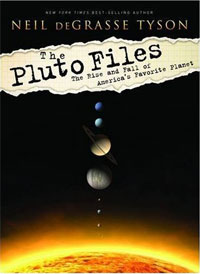Review: The Pluto Filesby Jeff Foust
|
| “We saw no value in counting planets—or counting anything,” Tyson recalls of his infamous museum exhibit. |
The title of the book is a clever double entendre: not only does it refer to the “plutophiles” in both the scientific community and the general public—particularly, it seems, schoolchildren—who defend the planetary status of Pluto, but also the volumes of correspondence, both printed and electronic, that Tyson has received over the years, overwhelmingly by said plutophiles. Tyson, as he recounts, got caught up in the debate after helping guide the development of the exhibits in the new Rose Center for Earth and Space Science that opened in 2000. (The discussion of whether Pluto should be classified as a planet had been going on for some time, but largely out of public view, one exception being a public forum that Tyson himself organized in 1999.) Tyson and colleagues decided to eschew the standard display of the solar system for one grouped by “families”: the Sun, the terrestrial planets, the asteroid belt, the gas giants, and finally the Kuiper Belt of distant icy bodies, of which Pluto appeared to be a natural member. “We saw no value in counting planets—or counting anything,” he recalls. That’s how the solar system exhibits were organized at the center, but it wasn't until nearly a year later—January 2001—that this non-standard approach, one that appeared to exclude Pluto (since it wasn’t included in a “Scales of the Universe” walkway that did include the other eight planets) got the public’s attention thanks to a front-page article in the New York Times. And that’s when the floodgates of scientific and popular opinion opened.
What follows is probably already familiar to may readers: the strong reaction to Pluto’s apparent exclusion from planethood by the museum, leading to extended debates that came to a head in Prague in 2006. Tyson illustrates this debate both figuratively, with anecdotes and snippets of the letters and emails he received on the topic, and literally, with published cartoons (many after Pluto’s “demotion”) and copies of handwritten letters from children. Tyson describes the points of view of those on both sides of the debate, but makes it clear that he is clearly on the side of those who eventually “won” in Prague in 2006 with a definition of planet that excludes Pluto. At one point, describing correspondence from planetarium directors who disagreed with the IAU decision, Tyson writes that their behavior “betrays hidden biases that do not tend to be subject to rational arguments.” Ouch!
| And while Tyson “won” the debate, it’s clear that he’s less enthused about any definition for a planet. |
Tyson does a fine job in this relatively short book describing the debate, and the science behind it, for the general public, in part because of his effort to tie the debate into popular culture and history (little known trivia: prior to the world’s discovery in 1930, “Pluto” was most commonly associated with a brand of mineral water sold as a means to cure constipation.) What Tyson doesn’t explain, unfortunately, is why Pluto’s planetary status captured the public’s attention and generated those cartoons, letters, and even songs included in the book. Was it the reaction to a sudden change in the fundamental “fact” that there were nine planets in the solar system? Was it a quasi-patriotic response (in the US, at least) to having the only planet discovered by an American losing its status by an international group? Or did the public somehow anthropomorphize Pluto, seeing it as a spunky underdog trying hard to hold its status against much larger worlds? That’s an examination that may have to wait for a grad student in the history of sciences, or sociology, looking for a thesis topic.
And while Tyson “won” the debate, it’s clear that he’s less enthused about any definition for a planet. Repeating arguments he has made previously (see “A planet-sized debate”, The Space Review, August 11, 2008), he writes that “the rote exercise of planet counting rings hollow and impedes the inquiry of a vastly richer landscape of science drawn from all that populates our cosmic environment.” Instead of thinking about planets, he suggests that teachers and their students “think of the solar system as families of objects with like properties” such as atmospheres, magnetic fields, volcanoes, and the like.
In the meantime, though, we’re left with the current, if imperfect, IAU definition, where Pluto is no longer a planet but, confusingly, a “dwarf planet”. (That distinction even trips up Tyson, who writes at one point that “Pluto is now a ‘dwarf’ planet.” It is not: Pluto is a “dwarf planet”, not a “dwarf” planet, since it is no longer considered a planet but a separate class of bodies that includes the word “planet” in its name but is not a subcategory of “planet”. See how confusing it can get?) But another IAU General Assembly is coming up this August, this time in Rio de Janeiro. And who knows? The Pluto Files—the book—might be published, but Tyson might not be able to close his own files of Pluto correspondence for some time to come.
